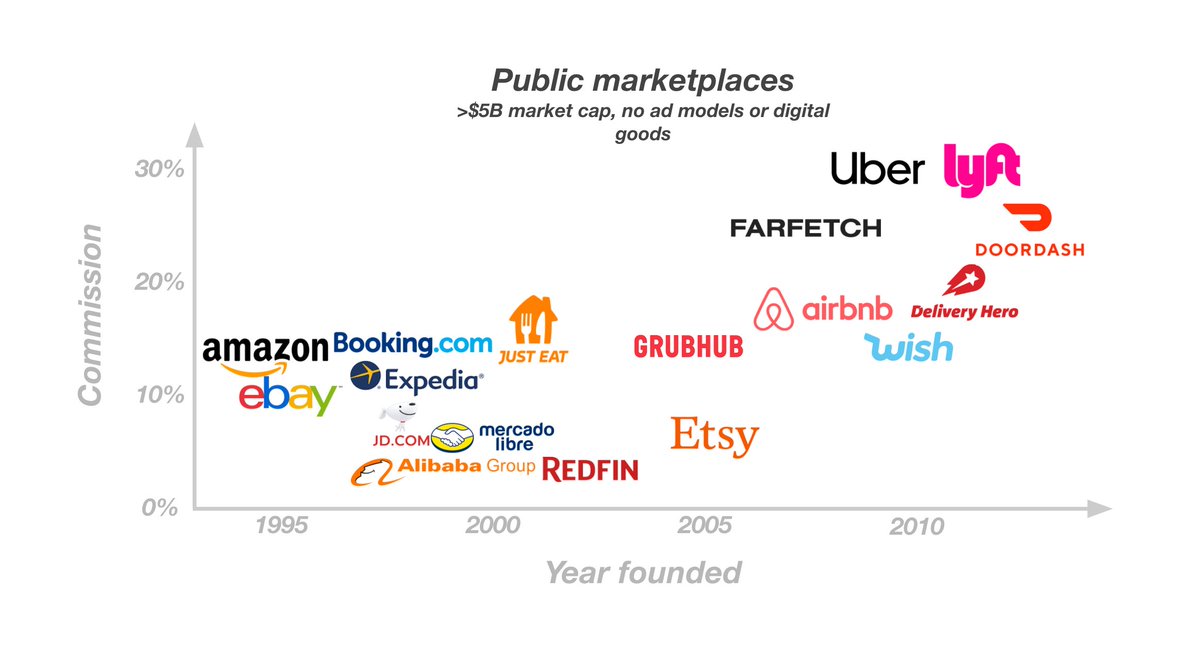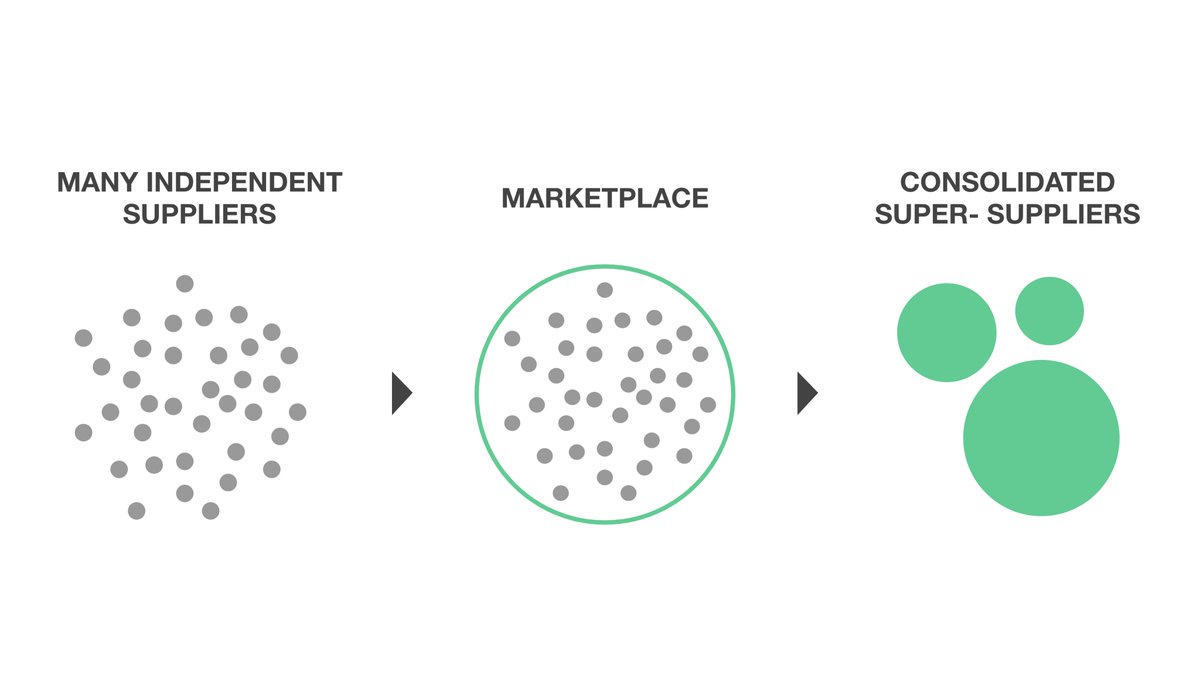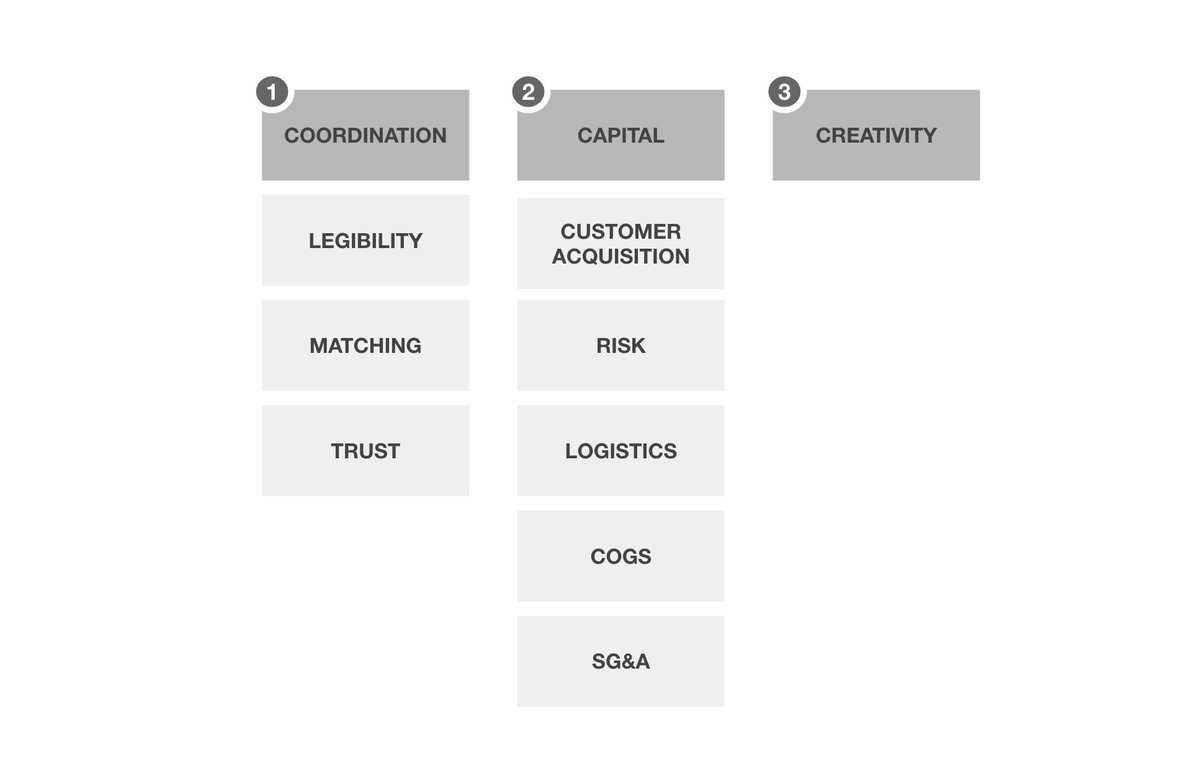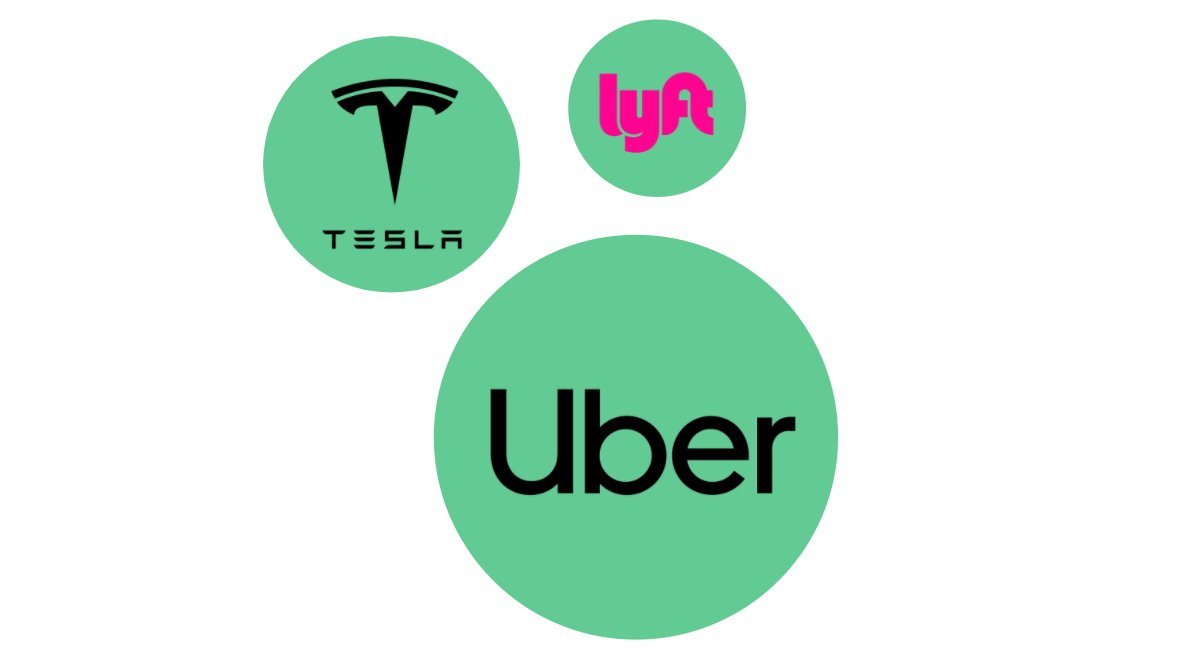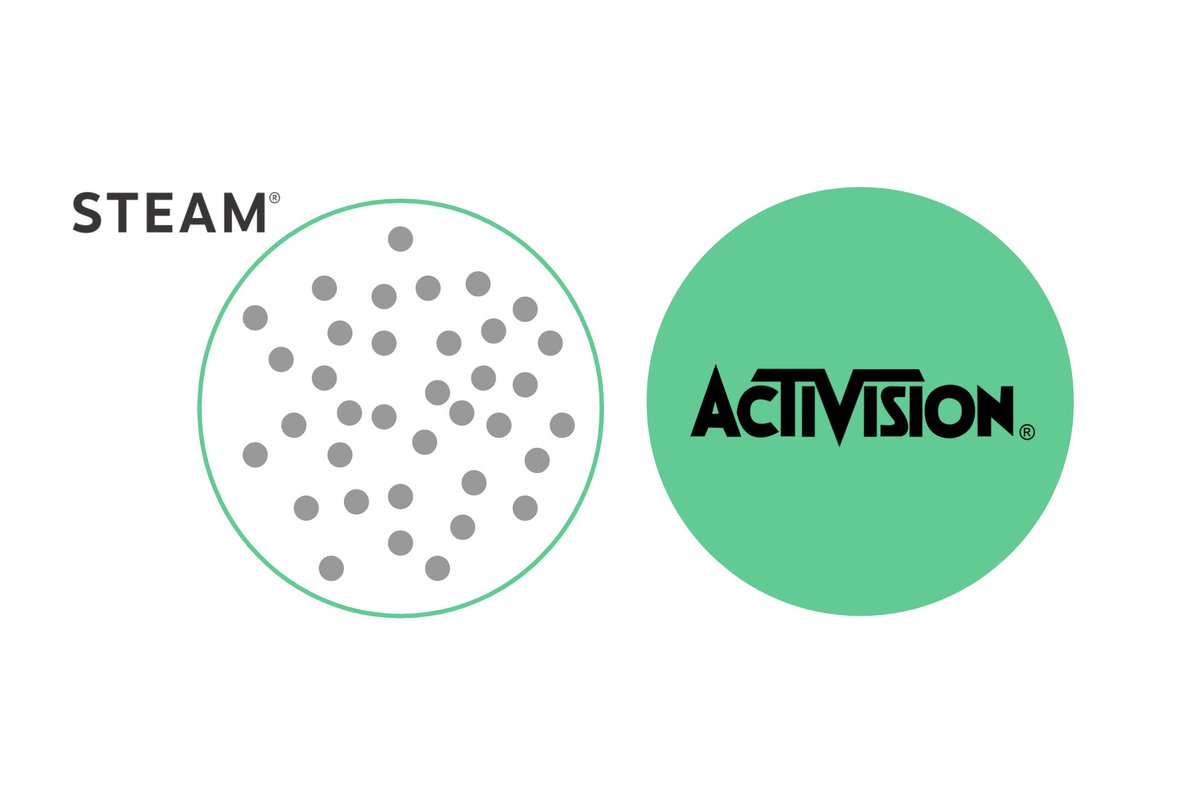“Creative intensity” is the rate at which products or services go stale and new ones must be created. It is the key factor in predicting the future of marketplaces.
On the left, the marketplace model will ultimately go extinct. On the right, it will persist.
A thread

On the left, the marketplace model will ultimately go extinct. On the right, it will persist.
A thread


When Airbnb and Doordash went public, they became two more data points in a long trend toward marketplaces with higher commissions and that do more work to justify those commissions:
But a business that does all the "work" and takes a 100% commission is… not a marketplace. It’s a big supplier.
Does that mean that marketplaces are just an intermediary step as an industry transitions from many independent suppliers to consolidated super-suppliers?
Does that mean that marketplaces are just an intermediary step as an industry transitions from many independent suppliers to consolidated super-suppliers?
This “work” includes 3 things:
 Coordination: making the product or service legible (categorizing, pricing), matching buyers and sellers, establishing trust
Coordination: making the product or service legible (categorizing, pricing), matching buyers and sellers, establishing trust
 Capital: the full cost and risk of doing business
Capital: the full cost and risk of doing business
 Creativity: figuring out what to sell in the first place
Creativity: figuring out what to sell in the first place
 Coordination: making the product or service legible (categorizing, pricing), matching buyers and sellers, establishing trust
Coordination: making the product or service legible (categorizing, pricing), matching buyers and sellers, establishing trust Capital: the full cost and risk of doing business
Capital: the full cost and risk of doing business Creativity: figuring out what to sell in the first place
Creativity: figuring out what to sell in the first place
This framework from @onecaseman and @GiladHorev give us some good categories to describe how marketplaces are evolving to do more and more of this work: https://caseyaccidental.com/marketplace-types
Light marketplaces are marketplace “1.0” like Zillow and HomeAdvisor that do just legibility and customer acquisition.
Vertically integrated "super suppliers" do everything. e.g. you can call Clutter a marketplace, but they're really a big, tech-enabled service provider.
Vertically integrated "super suppliers" do everything. e.g. you can call Clutter a marketplace, but they're really a big, tech-enabled service provider.
In between these two, we have every type of marketplace under the sun.
When a new marketplace model overtakes an old one, it is usually because they have taken on a new job that their suppliers used to do, and improved the customer experience:
Let's look at a few examples:
When a new marketplace model overtakes an old one, it is usually because they have taken on a new job that their suppliers used to do, and improved the customer experience:
Let's look at a few examples:
Trust -
eBay left a gap on trust that both GOAT and StockX exploited with their verification programs and money-back guarantees for collector sneakers.
@sarahtavel describes this here: https://sarahtavel.medium.com/white-space-for-building-a-marketplace-how-to-find-your-competitions-vulnerabilities-and-79674aa4d399
eBay left a gap on trust that both GOAT and StockX exploited with their verification programs and money-back guarantees for collector sneakers.
@sarahtavel describes this here: https://sarahtavel.medium.com/white-space-for-building-a-marketplace-how-to-find-your-competitions-vulnerabilities-and-79674aa4d399
Legibility -
Historically, local services marketplaces made intros and asked buyers/sellers to price the job.
With their Instant Match product, Thumbtack is automating price discovery and letting customer see prices in real time based on preferences, making it easier to hire.
Historically, local services marketplaces made intros and asked buyers/sellers to price the job.
With their Instant Match product, Thumbtack is automating price discovery and letting customer see prices in real time based on preferences, making it easier to hire.
Risk -
Retailers previously relied on sales reps to help them understand what to buy wholesale.
With access to more data, Faire is able to go a step farther and underwrite the transaction, offering net terms and free returns every time a retailer orders from a new brand.
Retailers previously relied on sales reps to help them understand what to buy wholesale.
With access to more data, Faire is able to go a step farther and underwrite the transaction, offering net terms and free returns every time a retailer orders from a new brand.
Logistics -
Marketplaces are increasingly reaching farther into the supplier cost structure.
By taking on responsibility for delivery, Doordash improved the customer experience and expanded the restaurants they could bring onto the marketplace relative to Grubhub.
Marketplaces are increasingly reaching farther into the supplier cost structure.
By taking on responsibility for delivery, Doordash improved the customer experience and expanded the restaurants they could bring onto the marketplace relative to Grubhub.
Creativity -
This is the process of suppliers envisioning new products and services to sell.
There are zero examples of marketplace figuring how to do this.
Even private label programs like Amazon Basics are just copying the "real" creators on the marketplace.
Why is this?
This is the process of suppliers envisioning new products and services to sell.
There are zero examples of marketplace figuring how to do this.
Even private label programs like Amazon Basics are just copying the "real" creators on the marketplace.
Why is this?
It is because creativity is not about doing a known job, but coming up with a new one.
Big companies are pretty good at solving capital and coordination problems, but terrible at innovation.
They're going to get worse at this as they scale, not better.
Big companies are pretty good at solving capital and coordination problems, but terrible at innovation.
They're going to get worse at this as they scale, not better.
Marketplaces will ultimately figure out how to solve coordination problems like price discovery, matching, and the supplier vetting and feedback.
They are optimization problems which benefit from more data and better ability to parse it, and we all know how that is going.
They are optimization problems which benefit from more data and better ability to parse it, and we all know how that is going.
They'll also all figure out how to underwrite risk, because it's the same kind of problem.
As @peteflint has noted, this means marketplaces will increasingly become fintechs and provide financing, banking, and insurance. https://www.nfx.com/post/fintech-enabled-marketplaces/
As @peteflint has noted, this means marketplaces will increasingly become fintechs and provide financing, banking, and insurance. https://www.nfx.com/post/fintech-enabled-marketplaces/
Taking on major components of the cost structure is harder because it is less clear you can get leverage through tech.
It's one of the reasons @benthompson said Doordash was "playing on hard mode" https://stratechery.com/2020/playing-on-hard-mode/
It's one of the reasons @benthompson said Doordash was "playing on hard mode" https://stratechery.com/2020/playing-on-hard-mode/
However, Grubhub might have said that owning logistics wouldn’t work at scale until Doordash and Postmates did it.
HomeAdvisor didn’t try to vertically integrate their moving category until Clutter did it.
HomeAdvisor didn’t try to vertically integrate their moving category until Clutter did it.
Long term it's likely that either:
(1) Marketplaces figure out how to take these costs in-house themselves; or
(2) They integrate with a 3rd party, like Doordash white label logistics or Stripe Capital, which is essentially "Risk as a Service" https://twitter.com/patrickc/status/1333834822330896384?s=20
(1) Marketplaces figure out how to take these costs in-house themselves; or
(2) They integrate with a 3rd party, like Doordash white label logistics or Stripe Capital, which is essentially "Risk as a Service" https://twitter.com/patrickc/status/1333834822330896384?s=20
Creativity is the only thing marketplaces won't solve, and so it is the filter that dictates the future of an industry.
Some industries have high creative intensity (media, art, new consumer products).
Some have low creative intensity (transportation, services, goods re-sale).
Some industries have high creative intensity (media, art, new consumer products).
Some have low creative intensity (transportation, services, goods re-sale).
Low creative intensity:
In ride sharing, as soon as full autonomy arrives the industry will flip to super-suppliers that handle the end-to-end customer experience, not marketplaces.
In ride sharing, as soon as full autonomy arrives the industry will flip to super-suppliers that handle the end-to-end customer experience, not marketplaces.
High creative intensity:
In video games, Steam's $5B+ indie game marketplace will be able to co-exist alongside the large game studios in the long term. No centralized company will figure out how to generate the diversity of creative expression required on their own.
In video games, Steam's $5B+ indie game marketplace will be able to co-exist alongside the large game studios in the long term. No centralized company will figure out how to generate the diversity of creative expression required on their own.
Read the full essay for more examples as well as implications for founders, operators, and investors: https://www.danhock.com/posts/the-future-of-marketplaces
 Grateful to @onecaseman @forr_funn @harshwithana @lennysan @zgrannis for helping sharpen my thinking on this essay
Grateful to @onecaseman @forr_funn @harshwithana @lennysan @zgrannis for helping sharpen my thinking on this essay

 Read on Twitter
Read on Twitter
